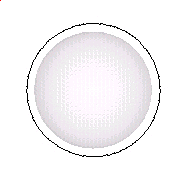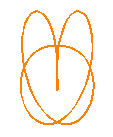Lynnclaire Dennis' Geometry:
The Pattern
Lynnclaire Dennis has many interesting ideas about geometric and nature. I am helping
Lynnclaire explore these ideas. My particular interest is in finding
connections between the geometry and physics.
Lynnclaire has told me that it would be interesting to explore a
specific polyhedron inside another polyhedron. The inner
most polyhedron had 48 cones of light coming out of it at 48
vertices. This polyhedron had 144 triangular faces.
The outer polyhedron had 120 triangular faces.
48 cones of light emerge from the center polyhedron, penertate
the outer polyhedron, turn around and re-enter the outer polyhedron.
Then, in the space between the two polyehdra, the light/energy
ties itself into a knot pattern.
These are some images of the knot pattern Lynnclaire
described to me from different perspectives.
Research and Information
Note that I have not tried to record the dates for each of the items below. Therefore, they
are not necessarily in any particular order.
NOTE: Some of the animations require JavaScript to be enable (one of your browser's
options that could be turned off.) If you are unable to play an animation, check that your
web browser has JavaScript enabled.

|
This is a presentation I gave at the University of Arizona in Tucson on (09-26-2007).
|

|
Looking at the "double" and "triple" torus and the different torus knots.
Maybe the Mereon knot is "simplest" knot. (03-11-2004)
|

|
Looking at the formation of the Pattern Knot by intersecting spirals
at various angles of intersection. (09-26-2003)
|

|
Looking at another 120 Polyhedron made out of 5 intersecting Jitterbugs.
The dynamics are very interesting. (02-16-2003)
|

|
Here is enumerate all the possible Lynnclaire-like knots. There are 3 different knots.
I also comment on the important role that twist tension in a knot plays in energy
minimization configuration simulations. (07-02-2002)
|

|
Playing with some wire models of the Pattern Knot lead me to see how it relates to the
Octahedron. (07-01-2002)
|
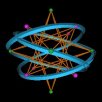
|
While exploring the dual polyhedra dynamics of the Cube and the Octahedron,
I discovered that the Pattern knot fits exactly the initial position of these
2 polyhedra. (06-23-2002)
|

|
Here is a pictorial presentation of all the basic polyhedra in the
120 Polyhedron. (06-08-2002)
|

|
From the old pattern.org web site: "Genesis of the Geometry". Some of this info is now
considered at best to be incomplete. (05-21-2002)
|
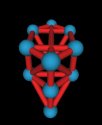
|
I saw the Tree of Life in a book on crop circles and started to think that this
might actually be a 3D figure. Here is an initial investigation. (03-19-2002)
|
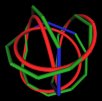
|
We have been looking for the way that the Pattern Knot could be formed within
the 120 Polyhedron. Here I trace out the path of the Pattern Knot using the
vertices and edges of the 120 Polyhedron. (03-12-2002)
|

|
Investigations into the creation of the Pattern Knot using helices,
cones and spirals. (03-09-2002)
|

|
The Cymatics work of Hans Jenny, creating structure out of sound waves, is
very relevant to...well, everything.
|

|
Exploring the way the Icosahedron and the Dodecahedron scale and pack together.
|

|
The Jitterbug seems to be taking center stage as the basic
motion, particularly in defining the polyhedra. Here I explore
some rotational behavior. Is there a connection to Quantum Mechanics?
|

|
Here I explore the various layers in the 120 Polyhedron. Some interesting
spacing sequences are found. But is there any application to be
made of this information??
|

|
Finally, I've organized and provide here all the coordinates and
vertex, edge and face maps for all the polyhedra in the120 polyhedron.
|

|
Here is a presentation I did at the 62rd Technology Conference, Oct. 25-26, 2001 at SUNY Oswego.
It is basically an introduction to various polyhedra with an emphases on how the Jitterbug
can be used to define all the polyhedra presented. (Best to use I.E. for viewing. Images
are low quality for size constraint reasons.)
|
